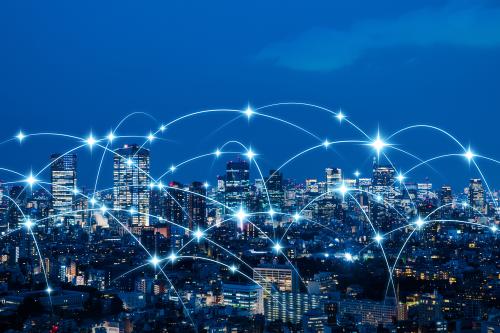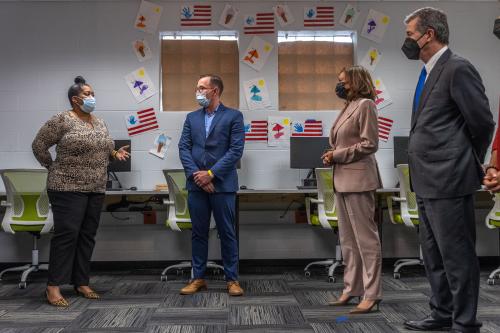No one ever thought that the extraordinary investment in families on the wrong side of digital opportunities would be winding down. And doing so at a time when more than 20 million eligible families have finally found affordable options to connect to remote work, distance learning, health care, and for greater connections to family members, and civil society. As of December 2023, 9.9 million participants of the Affordable Connectivity Program (ACP) were using the $30.00 per month discount toward fixed, or home broadband; 12 million for wireless services; and just under one percent on something else, like fixed wireless or satellite, according to ACP enrollment data. But last month, in response to the lack of a congressional reallocation of money and with funds dwindling, Chairwomen Jessica Rosenworcel of the Federal Communications Commission (FCC) penned a letter about the program’s fate and informed Congress that, on February 8, 2024, that the agency would start freezing new ACP enrollments. Meanwhile, states are steadily preparing to deploy federally subsidized, broadband deployments in areas that will be highly dependent on having subscribers for new and expanded assets. What the end of the ACP means for pending infrastructure, and the range of stakeholders from subscribers to community organizations has yet to be fully considered.
The Affordable Connectivity Program (ACP), one of many parts of the national effort to accelerate broadband as part of the Infrastructure Investment and Jobs Act, was established to address one of the contributing factors to the U.S. digital divide — monthly affordability of services. The initial $14 billion that once sounded like a generous investment toward these concerns is now expected to run out, prompting the FCC’s efforts to wind down the ACP. After a year of predictions that high enrollments would lead to this moment, Congress has finally started to take notice. On January 10, a bipartisan, bicameral group of legislators introduced the Affordable Connectivity Program Extension Act to provide temporary relief of $7 billion from Treasury funds. This bill would allocate $1 billion more than the White House proposed to Congress in 2023 and would not change the current ACP rules, which could upset some Republican hardliners already concerned about program eligibility who want to toughen the rules.
Over 400 organizations, including national and local entities, internet service providers (ISPs), trade associations, and labor unions, have demonstrated their support for this new legislative proposal, and this all makes sense given the interests of these stakeholders, who are concerned about impacted populations and/or the ramifications on the broadband marketplace should the program abruptly end.
Saving the ACP should be based on what has become a known fact: being connected to the internet really matters in an increasingly digital society. Access to high-speed broadband has become a critical social determinant of well-being, especially when connectivity promotes equitable economic and social outcomes for users and their families. The ACP also is critical to the achievement and sustainability of the much-anticipated broadband infrastructure goals, which will benefit both red and blue states.
The Broadband Equity and Deployment Program (BEAD) is run out of the U.S. Department of Commerce and is currently reviewing and approving state plans to accelerate internet access, particularly in areas that have been under- or un-served by current facilities. The program has been allocated about $45 billion to further such deployments and contextualize digital equity programs to incent people to use them. Because of the focus on fiber, small and medium-sized providers are likely leveraging the funding for their buildouts. But without more certain subscribership, these companies could experience extreme financial consequences that lead to a range of outcomes — some even resulting in bankruptcies. Over the years, there have been some precedents around this correlation between supply and demand. Early efforts to build municipally-owned broadband networks struggled to find the appropriate level of solvency after huge sunk costs and debt loads, according to Christopher Yoo. In the end, some cities, contractors, and subs learned the hard way as they frontloaded huge amounts of cash and credit and believed the government would anchor their business models. Instead, many experienced the opposite and learned in the early days of municipal broadband about the importance of having healthy financial conditions on both the supply and demand sides for network revenues and sustainability.
The business realities may not be too far off in states with higher rates of poverty where the additional savings of the ACP have proven beneficial to constituents. For example, three states with the highest percentages of poverty in the United States are Mississippi, Louisiana, and West Virginia. Combined, almost one million people are currently enrolled in ACP in these states, according to recent FCC data, and that has translated into more than $25 million in household savings for them due to having an affordable and seamless high-speed broadband connection. These states with higher national poverty are expected to receive over one billion in BEAD funding each, which could contribute to lower costs for consumers, and the businesses, as well as organizations, that serve them. But without the ACP or a consumer-driven subsidy to support the broadband marketplace, existing and new broadband providers, cash-strapped customers, and surrounding businesses depending on the connectivity for economic gain all lose in one or many ways.
Then there are the concerns focused on the losses of the companies that are providing low-cost broadband solutions when the ACP ends. New Street Research completed a financial evaluation on one of the participating ISPs. Charter Communications has more than 4 million ACP, fixed broadband subscribers currently. The research findings showed that some of their customers — particularly those who knew that their ACP subsidy was not permanent — may be fine, while others will be severed from their connections due to the returning concern of affordability. And it is highly likely that this will impact other ISPs servicing the ACP, who may also have to decide on the future of the lower cost tier, which was not only bringing in new customers, but also allowing for operational expansion in areas such as customer service, accounting, or compliance.
Added to those who will lose if the ACP ends are national and community-based organizations who have advanced the digital equity movement and have made plans for digital literacy programming that are dependent on ACP enrollments. Various groups are leveraging home broadband to support their programs geared toward homework help, virtual health care, public benefits and housing recertification, community-building, workforce training and re-entry, and will be greatly impacted if the program is not temporarily or permanently restored. One of the older national, digital equity organizations, Connected Nation, has worked to connect more people to the internet in some of the more rural parts of the Midwest, and is an organization that started a few years after I entered this space in the late nineties. In their recent statement about the ACP, they summarized the sentiments of many national and community organizations facing the end of ACP: “This vital program, which significantly lowers monthly internet bills for millions of struggling Americans, is a key lifeline to online work and education opportunities that will suddenly vanish later this spring if Congress fails to act.” In the end, these groups understand the daily decisions that individuals and their families must make between having broadband and bread – despite the former driving a path toward social mobility.
Right now, the ball is in the court of Congress to act or not on the viability of internet subsidies for families who need them most. From the accounts of current research and public reporting on the impact of a shutdown, there is largely agreement that it is not a partisan program — subscribers from all geographies, and backgrounds are enrolled, including those in urban and rural America. But it will be, if this effective strategy to tackle the decades-long challenge of making the internet affordable in the backdrop of more available broadband assets fails to see sunlight beyond its pending expiration.
-
Acknowledgements and disclosures
Charter Communications, Inc. is a general, unrestricted donors to the Brookings Institution. The findings, interpretations, and conclusions posted in this piece are solely those of the author and are not influenced by any donation.







Commentary
Everyone loses if the Affordable Connectivity Program ends
February 6, 2024